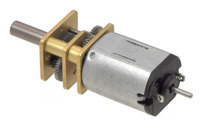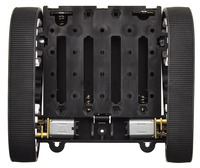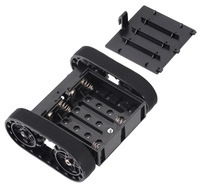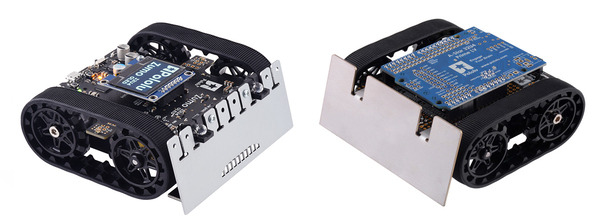The Pololu Zumo 32U4 OLED robot is a versatile tracked robot based on the Arduino-compatible ATmega32U4 MCU, and this kit contains most of the parts you need to build one—all you need to add are a pair of micro metal gearmotors , four AA batteries , and a USB A to Micro-B cable .
Special Order
Shipping from $9.90
+94 more from our supplier in 7-10 days
Our Code: SKU-007999
Supplier Link: [Pololu MPN:4990]
The Pololu Zumo 32U4 OLED robot is a versatile tracked robot based on the Arduino-compatible ATmega32U4 MCU, and this kit contains most of the parts you need to build one—all you need to add are a pair of micro metal gearmotors, four AA batteries, and a USB A to Micro-B cable. It includes integrated dual motor drivers, a graphical OLED display, quadrature encoders, line sensors, side and front proximity sensors, and a full IMU. The assembled robot is less than 10 cm × 10 cm—small enough to qualify for Mini Sumo. This product is a kit; assembly (including soldering) is required.
The Zumo 32U4 OLED is a highly integrated, user-programmable and customisable tracked robot. It measures less than 10 cm on each side and weighs approximately 275 g with batteries (160 g without), so it is both small enough and light enough to qualify for Mini-Sumo competitions, but its versatility makes it capable of much more than just robot sumo battles.
At the heart of the Zumo 32U4 is an ATmega32U4 AVR microcontroller from Microchip (formerly Atmel), and like our A-Star 32U4 programmable controllers, the Zumo 32U4 features a USB interface and ships preloaded with an Arduino-compatible bootloader. A software add-on is available that makes it easy to program the robot from the Arduino environment, and we have Arduino libraries and example sketches to help get you started. A USB A to Micro-B cable (not included) is required for programming. For advanced users who want to customize or enhance their robots with additional peripherals, the robot’s power rails and microcontroller’s I/O lines can be accessed via 0.1″-spaced through-holes along the sides and front of the main board.
|
The Zumo 32U4 features two H-bridge motor drivers and a variety of integrated sensors, including a pair of quadrature encoders for closed-loop motor control, a complete inertial measurement unit (3-axis accelerometer, gyro, and magnetometer), five downwards-facing reflectance sensors for line-following or edge-detection, and front- and side-facing proximity sensors for obstacle detection and ranging. Three on-board pushbuttons offer a convenient interface for user input, and a 128×64 graphical OLED display, buzzer, and indicator LEDs allow the robot to provide feedback.
The Zumo 32U4 OLED robot is available fully assembled with three different motor options (see the Motors section below for more information on how these different gear ratios perform):
The Zumo 32U4 OLED robot is also available as a kit (without motors) for those who would prefer to assemble it themselves or who want to use different motors than those in the three assembled versions.
March 2024 update: We are transitioning the OLED displays from units with blue PCBs to functionally identical versions with black PCBs. Some of the pictures and videos on our website still show the original blue displays.
This version of the Zumo 32U4 OLED robot (item #4990) is a kit; assembly (including soldering) is required. Motors and batteries are sold separately. A USB A to Micro-B cable (not included) is required for programming.
With the exception of motors, batteries, and a USB A to Micro-B cable, this kit contains everything necessary to build and operate a Zumo 32U4 robot:
See the Zumo 32U4 robot user’s guide for detailed assembly instructions.
This is a newer Zumo 32U4 OLED Robot Kit with a graphical OLED display. For its original version counterpart with an LCD, see the Zumo 32U4 Robot Kit.
  |
Micro Metal Gearmotor with Extended Motor Shaft. |
|---|
  |
The Zumo chassis uses two micro metal gearmotors, one for each tread. The ideal motors for your robot depend on your desired torque, speed, and current draw, so motors are not included with the kit version of the chassis (motors are included with the assembled versions of the Zumo 32U4 robot). We generally recommend using high-power (HP or HPCB, which have long-life carbon brushes) versions of our micro metal gearmotors since the tracks require a decent amount of torque to move effectively; higher gear ratios of the non-HP motors might work if you want lower current draw, but they will be slower and offer less control. Specifically, we primarily recommend the 50:1, 75:1, or 100:1 HP (or HPCB) motors for use with this chassis, and these are the versions we include in our assembled Zumo 32U4 robot. Additionally, be sure to get a version with extended motor shafts if you want to be able to use the Zumo 32U4’s encoders.
You can use the following table to compare these three gear ratios in more detail. The first four columns are specifications of the motors themselves, while the last column is the measured top speed of a Zumo chassis loaded to a weight of 500 g and driven with these motors. Note that the specifications are for 6V operation, which is approximately the voltage you would get with four alkaline batteries; four NiMH AA cells will typically provide less than 5V.
| Micro Metal Gearmotor |
Free-Run Speed @ 6V |
Stall Torque @ 6V |
Stall Current @ 6V |
Top Zumo Speed @ 6V and 500g |
|
|---|---|---|---|---|---|
| 50:1 HP or 50:1 HPCB | 625 RPM | 15 oz·in | 1600 mA | 40 in/s | (100 cm/s) |
| 75:1 HP or 75:1 HPCB | 400 RPM | 22 oz·in | 1600 mA | 25 in/s | (65 cm/s) |
| 100:1 HP or 100:1 HPCB | 320 RPM | 30 oz·in | 1600 mA | 20 in/s | (50 cm/s) |
  |
The Zumo 32U4 robot runs off of four AA batteries. It works with both alkaline and NiMH batteries, though we recommend using rechargeable AA NiMH cells.
|
|
|
Our older Zumo robot for Arduino, built with a Zumo Shield, is another Arduino-compatible robotic platform based on the Zumo chassis. The Zumo Shield mounts to the Zumo chassis and features motor drivers and various sensors, but it does not have an integrated microcontroller; rather, it is designed to interface with boards that have a standard Arduino form factor, like an Arduino Uno, Arduino Leonardo, or A-Star 32U4 Prime, and these boards serve as the main controller for the robot.
  |
A Zumo 32U4 OLED robot (left) and a Zumo robot for Arduino with an A-Star 32U4 Prime LV (right). |
|---|
By contrast, the Zumo 32U4 OLED includes an on-board ATmega32U4 microcontroller (the same one used in the Leonardo and A-Star 32U4 boards), combining the functions of the Zumo Shield and the separate Arduino controller into a single, compact board that is just as easy to program as a standard Arduino or A-Star thanks to its USB interface and preloaded Arduino-compatible bootloader. The Zumo 32U4 retains all the features of the Zumo shield (e.g. dual motor drivers, inertial sensors, and buzzer) while adding many new features, including dual quadrature encoders, proximity sensors, a graphical OLED display, and two extra user pushbuttons.
Some of the pin mappings and software libraries differ between the Zumo 32U4 and Zumo robot for Arduino, so programs written for one robot generally need to be modified to work on the other.
| Size: | 96L × 99W × 39H mm |
|---|---|
| Weight: | 160 g1 |
| Processor: | ATmega32U4 @ 16 MHz |
|---|---|
| RAM size: | 2560 bytes |
| Program memory size: | 32 Kbytes2 |
| External programmer required?: | N |
| Assembled: | N |
| Version: | kit — assembly required, motors not included |
| PCB dev codes: | zum02d |
|---|---|
| Other PCB markings: | 0J13542 |
User’s manual for the Pololu Zumo 32U4 robot.
This download contains the Windows drivers for the A-Star 32U4 and the rest of our 32U4 family of boards.
This model uses simplified models of the control electronics to reduce the file size. More detailed models are available separately of the Zumo 32U4 OLED main board (24MB step) and Zumo 32U4 front sensor array (4MB step).
This DXF drawing shows the locations of all of the board’s holes.
Datasheet for the sensor used on the QTR-3RC and QTR-3A Reflectance Sensor Arrays, the Zumo 32U4 robot front sensor array, and the Optical Encoders for micro metal gearmotors.
The Zumo32U4 library for the Arduino IDE helps interface with the on-board hardware on the Zumo 32U4 robot.
This repository contains Arduino add-on files, Windows drivers, and bootloaders for the A-Star 328PB, A-Star 32U4, and the rest of our 32U4 family of boards.
Microchip’s product page for the ATmega32U4 AVR microcontroller, with links to its datasheet, application notes, and other resources.